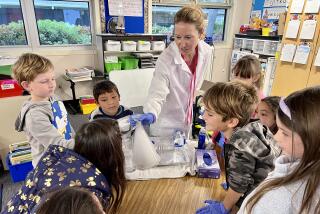Torrance Facility Puts ‘Gee Whiz!’ Into Science Classes
Inside one classroom, 30 students squealed with delight at flickering computer screens. Next door, other children whooped exuberantly as they sat inside an inflated planetarium. Outside, dozens of equally noisy youngsters added to the din as they chased after giant soap bubbles.
So much for the myth of the golden virtue of classroom silence. The smiling instructors of these children did nothing to quiet their charges.
The constant clamor is exactly what they had in mind. And they hope to see plenty more of it.
“We’re hoping someday all of our classrooms will look like this, or better,” said Lucille LeMieux, a Torrance Unified School District curriculum consultant, gesturing to a room crowded with computers and high-tech teaching gadgets.
“Our district is committed to preparing students for the 21st Century,” she said.
On Friday, district officials will stage an official dedication of their new “classroom of the future,” called the Textor Room, and its next-door neighbor, the Discovery Center, both located at the Levy Curriculum Center in south Torrance.
Built with a $36,000 bequest from the estate of a former Torrance teacher, Mae Grudin Harris-Textor, and a $167,000 special federal grant, the two rooms are intended to bring science and math lessons alive as one intriguing whole.
The Torrance district’s vision of education’s high-tech future, one of 361 grant requests filed nationwide, so impressed federal officials that they awarded the Discovery Center one of the largest of 29 math and science grants given nationwide, according to Department of Education spokeswoman Jane Glickman. The Torrance grant also was the only one given to a California school district, she said.
With the money, district officials have created a mini-museum of science, crammed with modern equipment and space-age experiments, with a healthy mix of time-honored teaching tools, such as wooden dowels, straws and Lego pieces.
Students from any school in Torrance--public or private--are welcome to use the center, LeMieux said, noting that morning sessions at the center--when bus transportation for public students is most readily available--are almost completely booked for this school year.
Schools close enough for children to walk to the center have some classes scheduled to visit the center every week, LeMieux said. Others hope to bring in some students as often as once a month.
LeMieux, who first conceived of the Discovery Center and was one of six instructors who wrote the grant application, said one of the central ideas was to create a place where teachers uncomfortable with science and math could ease their anxiety.
During the summer months, teachers unfamiliar with the intricacies of science and math filled the Discovery Center, learning by enjoying the same experiments that they now use to teach their students.
They played with a ruby red laser, bouncing it off quartz, light bulbs and milk cartons to see what they could learn about its light. They experimented with “stream tables,” tanks filled with water and grains of silicon to show how erosion works.
In the Textor Room, they learned how to operate a space-age blackboard that prints out duplicates of everything written on its surface and a poster-maker that turns information written on small sheets of paper into classroom-size enlargements.
“The teachers sounded just like the kids. They were saying, ‘Oooh, aaaah,’ ” said Magruder Middle School teacher Kathy Cleary, who both taught and learned during the summer sessions and who helped write the grant.
The idea behind both the teacher training and the student sessions is to get everyone to figure out what is happening and why.
“You don’t want to just come in and cookbook them. We try to lead them into making a discovery because they buy into it that way,” said Chuck Pillet, a Torrance district science mentor teacher who has helped select and set up the center’s equipment.
All the kids know is that they get to have a darned good time.
“Rad!” “Cool!” “Neato!” yelled enthusiastic 8- and 9-year-olds from Yukon and Walteria elementary schools as each new experiment and demonstration unfolded.
Students in the Textor Room, given a random collection of computer disks, eagerly jumped from screen to screen, ordering musical lions to appear, answering animated math questions and watching planets orbit through the solar system.
Later, Walteria teacher Kay Griffith gathered the children around to look at a rainbow-hued laser video disk.
“Remember how we learned about all the information you can put on one of those computer disks?” Griffith asked the class. “Well, this one record holds as much as 40,000 computer disks.”
The children stared at the video disk with renewed appreciation.
“I’d like to have a classroom like this all the time,” said Amie Hagins, 9, who said she plans to become either “a cake-maker or someone who discovers crystals.”
Outside, budding planet researcher Martin Mora, 8, from Yukon school learned about surface tension by creating gigantic soap bubbles. Noting that one of his bubbles “looks just like Earth,” Martin said he wants to keep coming back to the Discovery Center.
“I think this is really fun, and I’m glad they earned the money to make this for us,” he said.
More to Read
Sign up for Essential California
The most important California stories and recommendations in your inbox every morning.
You may occasionally receive promotional content from the Los Angeles Times.










